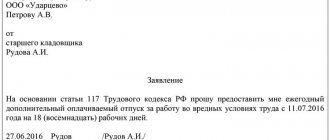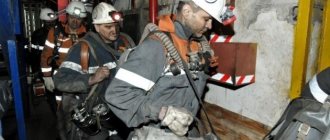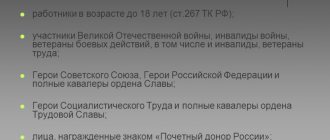24.06.2019
0
150
8 min.
Each officially employed citizen can count on a certain number of days of rest (minimum 28). However, some categories of workers are also granted additional leave for hazardous working conditions. In this way, the employer compensates for the negative impact of the working environment on the human body. But often, despite the excellent opportunity to at least partially improve their health and restore their working capacity, employees are interested in whether these days can be compensated with money.
What has changed in the procedure for granting additional permission?
Firstly, Part 2 of Article 117 of the Labor Code clearly states that the minimum duration of such leave is seven calendar days. The same minimum was established earlier by Decree of the Government of the Russian Federation of November 20, 2008 N 870, but it was not recorded in the Labor Code.
Secondly, additional leave is now provided only to those employees whose working conditions, based on the results of a special assessment, are classified as harmful conditions of the 2nd, 3rd or 4th degree or hazardous working conditions (Part 1 of Article 117 of the Labor Code of the Russian Federation).
Let us recall that four classes of working conditions have been established. Of these, the third class has four subclasses depending on the degree of harmfulness of working conditions (Article 14 of the Federal Law of December 28, 2013 N 426-FZ, hereinafter referred to as Law N 426-FZ). Classes of working conditions are given in the table.
Table
Classes of working conditions
| Class of working conditions | Name of working conditions |
| 1 | Optimal |
| 2 | Acceptable |
| 3 | Harmful |
| Subclasses | |
| 3.1 | Harmful working conditions 1st degree |
| 3.2 | Harmful working conditions of the 2nd degree |
| 3.3 | Harmful working conditions of the 3rd degree |
| 3.4 | Harmful working conditions of the 4th degree |
| 4 | Dangerous |
The third important innovation. Part of the additional leave for harm exceeding the minimum duration may be replaced by monetary compensation. This compensation is paid if (part 4 of article 117 of the Labor Code of the Russian Federation):
— such a possibility is provided for by industry (inter-industry) agreement and collective agreement;
— this has the written consent of the employee himself, drawn up in the form of an additional agreement to the employment contract;
— the harmfulness of working conditions is confirmed by the results of a special assessment of working conditions.
The amounts, as well as the conditions for payment of compensation, are established by industry (inter-industry) agreements and collective agreements.
The legislative framework
Ensuring the right of employees at whose workplaces during a special assessment harmful factors characteristic of hazard classes 2, 3 and 4 to additional rest is devoted to Article 117. Labor Code of the Russian Federation.
It also says that the duration of preferential leave is regulated by industry agreements and collective agreements between the administration and labor collectives. The lower ceiling is set at 7 calendar days.
What is a special assessment?
A special assessment of jobs has been introduced in our country since 01.01.
2014. All rules and circumstances of its organization are regulated by Law No. 426 Federal Law adopted on December 28, 2013. The survey of working conditions must certainly cover 100% of the workplaces provided for by staffing schedules, except for:
- Homeworkers.
- Working remotely using electronic communication channels.
- Employees who are hired by an individual who is not an individual entrepreneur.
A special assessment can only be entrusted to an expert organization that meets all the requirements of Federal Law 426. An agreement on the provision of paid services is concluded between her and the employer.
Its certified laboratories carry out all available tests (measurements or examinations) of negative impacts. Guided by the received protocols and the requirements of the law, the experts of the implementing organization give an opinion on whether the workplace belongs to one of four classes of working conditions:
- Optimal (no influence of negative factors was detected).
- Acceptable (negative impacts were detected, but within the limits of current standards).
- Harmful, consisting of four subclasses: first, second, third and fourth degrees.
- Dangerous.
At the time of signing the act of completed work, the contractor hands over to the customer maps drawn up for all surveyed workplaces, where the class of negative conditions to which it is assigned is certainly recorded.
This map will be the basis for the development of various projects and optimization of costs in the field of labor protection, and will also serve as the basis for employees to receive additional leaves in accordance with Article 117 of the Labor Code.
What determines the length of vacation?
The duration of additional rest for the second, third and fourth hazard classes in calendar days is regulated by industry agreements and is fixed by collective agreements between the administration and the workforce.
For example, in the industry agreement on the construction and building materials industry for 2021 - 2021. The following standards for preferential leave have been determined:
- For the second class of harmfulness - 7 k.d.;
- For the third class of harmfulness - 10k.d.;
- For the fourth class of harmfulness - 14 k.d.
The industry agreement of the Russian Ministry of Health provides recommendations to healthcare institutions in their collective agreements to determine the following duration of additional leave:
- 2 – at least seven calendar days;
- 3 – at least eight calendar days;
- 4 – at least nine calendar days;
- 4th grade – at least ten calendar days.
Industry agreements between management and trade unions have been concluded in all sectors of the economy and social sphere. Based on their recommendations, each institution or organization concludes its own collective agreement.
What to do if there is no special assessment
A special assessment of working conditions has been carried out since the beginning of 2014. Before this, their certification was mandatory. When the protocol drawn up based on the results of the certification indicated the presence of negative factors in a certain workplace, the employee was entitled by law to days of additional rest, the number of which was recorded in Soviet-era regulatory documents No. 273/P-20 of November 21, 1975 and No. 298 /P-22 dated October 25, 1974
Cards issued during workplace certification were valid for 5 years. Law 426 Federal Law provides for a phased transition from certification to special assessment until the end of 2021. By this point, exactly five years will have passed since the last time certification was allowed, and it will lose relevance for all organizations.
If the company’s cards issued during the certification of working conditions are current today, then representatives of professions included in the list 298/P-22 are given leave every year, the amount of which is prescribed in instructions 273/P-20.
Two things should not be overlooked here:
- According to the instructions, the period of preferential leave is calculated in working days, but according to current laws, all leaves are calculated in calendar days. A translation is needed, for this, from the start date of the additional leave, the working days taken from the instructions are counted, the end day is determined, and the days are counted according to the calendar, excluding only official holidays.
- If it turns out that the vacation calculated in this way lasts less than seven calendar days, it will have to be increased to this amount, because this is provided for by the Labor Code.
Is special assessment a prerequisite for granting additional leave?
Until January 1, 2014, additional leave was granted to all employees whose work involved exposure to harmful factors on their health, determined based on the results of workplace certification without specifying the degree of harm. There was also no possibility of replacing part of the additional leave for harmful activities with monetary compensation.
At first glance, it may seem that in order to provide an employee with additional paid leave, the organization must conduct a special assessment of jobs this year. However, it is not.
Special situations
There are some professions that also require additional leave. Despite the fact that employment conditions are not particularly dangerous or harmful, risks are present. In particular, the Labor Code indicates the need to provide rest for medical workers. Not all specialties offer this privilege; the full list is presented in PP No. 482, but at its discretion the employer has the right to assign leave to everyone. The following days of rest in excess of the norm are mandatory:
- health workers treating tuberculosis and HIV infections;
- employees of the psychiatric department.
Attention! The employer's refusal to provide additional days off to the above categories of citizens is a violation of the law. Part-time workers also have the right to receive a day's vacation. The principle of calculating periods is similar.
The company carried out certification of workplaces before January 1, 2014
The results of certification carried out before January 1, 2014 are valid for five years from the date of completion of this certification (Part 4 of Article 27 of Law No. 426-FZ). Cases when a special assessment of working conditions needs to be carried out unscheduled are listed in Article 17 of Law N 426-FZ. For example, when commissioning new jobs.
That is, if before January 1, 2014, the company carried out certification of workplaces, then, in general, a special assessment of working conditions in relation to such workplaces need not be carried out for five years from the date of completion of this certification. For example, if a company carried out routine certification in 2013, then working conditions can be assessed according to the new rules only in 2018.
If, based on the results of certification carried out before January 1, 2014, the employee’s working conditions were recognized as harmful (dangerous), the company may continue to provide him with additional leave in the same manner, guided by these results (Part 4 of Article 27 of Law No. 426-FZ).
Who should be granted additional leave in 2014?
Thus, this year, additional leave is granted to employees employed:
- in harmful and (or) dangerous working conditions, confirmed by workplace certification carried out before January 1, 2014 in the manner prescribed by Order of the Ministry of Health and Social Development of Russia dated April 26, 2011 N 342n;
- in hazardous working conditions of the 2nd, 3rd or 4th degree or hazardous working conditions confirmed by a special assessment of working conditions carried out after January 1, 2014 in the manner prescribed by Law No. 426-FZ.
Classification
According to the Law on the Assessment of Working Conditions No. 426-FZ dated December 28, 2013, according to the degree of negative impact, working conditions are divided into 4 groups:
- optimal;
- acceptable;
- harmful;
- dangerous.
Harmful (class 3) are considered working conditions in which the level of exposure to harmful factors on a person is higher than the hygienic standards established for the working environment.
The following classification of negative production environment has been established:
| Subclass 3.1 | The employee is exposed to harmful factors. After their influence, the functions of the worker’s body are restored. This requires more time than stopping them until the next work shift. The risk of poor health increases. |
| Subclass 3.2 | The worker is affected by harmful factors in the production process. They lead to permanent functional changes in the employee’s body. They contribute to the emergence and progression of the initial stages of occupational diseases without loss of professional ability, appearing after prolonged exposure to damaging factors (15 years or more). |
| Subclass 3.3 | Exposure to harmful factors leads to permanent health problems for workers. Mild and moderate forms of occupational diseases develop with loss of professional ability during the working period. |
| Subclass 3.4 | Conditions of activity in which a person is exposed to harmful and dangerous factors. They lead to severe occupational diseases with complete loss of ability to work during the working period. |
Dangerous (class 4) working conditions are those in which the employee is exposed to negative and dangerous factors. The degree of their influence can endanger a person’s life during a working day or part of it.
The consequence of their influence is a high probability of progression of an acute occupational disease during the working period. Working in such conditions is prohibited, except in emergency situations.
Procedure for granting leave
The procedure for determining the duration of additional leave for harmful working conditions was established by the Instruction approved by the Decree of the State Labor Committee of the USSR and the Presidium of the All-Union Central Council of Trade Unions dated November 21, 1975 N 273/P-20 (hereinafter referred to as the Instruction).
The list of industries with hazardous working conditions, work in which gives the right to additional leave, was once approved by the Decree of the State Committee for Labor of the USSR and the Presidium of the All-Union Central Council of Trade Unions dated October 25, 1974 N 298/P-22 (hereinafter referred to as the List). In it, the duration of additional leave depends on the type of activity, working conditions and position of the employee.
These documents are still in force to the extent that they do not contradict the Labor Code (Article 423 of the Labor Code of the Russian Federation). The duration of additional leave, depending on working conditions, still needs to be determined based on the List and Instructions.
The duration of additional leave must be as specified in the List (but not lower than the minimum). Such conclusions follow, in particular, from the Ruling of the Supreme Court of the Russian Federation dated November 1, 2012 N APL12-651 and the decision of the Supreme Court of the Russian Federation dated January 14, 2013 N AKPI12-1570.
Required formulas
To determine the amount of rest for harmful activities
How to calculate the duration of vacation? To calculate the days of the type of rest in question, it is first necessary to determine the number of full months in which the person worked under harmful conditions:
KPM = DVR / (RDG / 12),
- where KPM is the number of full months of work with harmful conditions;
- DWR - the number of working days per year when the employee was engaged in hazardous work;
- RDG – the total number of working days in a year.
The next step is to calculate the number of days when the employee will be on legal rest due to harmful conditions:
DDO = KPM x DOG / 12 – DOI,
- where DDO – days of additional leave that are subject to payment;
- DOG – days of additional rest that an employee is entitled to for a full year of work;
- DOI - days of leave for harmful working conditions, which he has already used this year.
It should be noted that the KPM value does not have to be an integer , unlike the DDO value - it is impossible to send an employee to sit at home for 6.73 days. This indicator, in accordance with Letter of the Ministry of Labor No. 14 - 2 / B - 1045 dated October 18, 2016, must be rounded in favor of the employee.
For dangerous work
If additional leave for hazardous conditions is accrued in working days, it is calculated based on a six-day working week, as stated in Letter of the Ministry of Labor No. 625-ВВ dated 02/01/2002. In this case, the amount of the average daily benefit should also be calculated based on a six-day working week. For this calculation, it is best to use the production calendar.
The formula for calculating the amount of leave for harmful activities will look like this:
O = SDP x KDO,
- where O is the amount of vacation accrued to the employee;
- SDZ – the amount of the average daily wage for calculating rest for harmful activities;
- KDO - the number of vacation days granted to the employee.
In this case, the amount of average daily earnings in working days will differ:
SDZ = ZPG / CODE,
- where ZPG is wages for actually worked outputs for the year before the start of the vacation;
- CODE - the number of days worked in a six-day working week.
When calculating the value of CODE and PPG, you should not take into account sick days, various financial assistance and everything for which insurance premiums are not charged, as well as various distractions from the work process (donating blood, business trips, participation in competitions). If these payments are accrued in calendar days, they must be converted into working days during a six-day period in accordance with the production calendar.
Duration
How to calculate days and their number? Let's look at the example of calculating rest days. Employee Vinokur V.V. from 02/05/2017 was transferred to a workshop with hazardous working conditions. In this profession and in this workshop, he is entitled to 11 days of additional leave for harmful activities. However, from June 22 to July 3, Vinokur was ill. Let's calculate how many days of additional leave he is entitled to as of 01/01/2018.
Let's calculate V.V. Vinokura number of shifts worked by him for the billing period from January to December 2021. They will be:
| Months | Working days according to schedule | Days worked |
| January | 17 | 0 |
| February | 18 | 15 |
| March | 22 | 22 |
| April | 20 | 20 |
| May | 20 | 20 |
| June | 21 | 14 |
| July | 21 | 20 |
| August | 23 | 23 |
| September | 21 | 21 |
| October | 22 | 22 |
| November | 21 | 21 |
| December | 21 | 21 |
| Total: | 247 | 219 |
Let's calculate the working days according to the schedule for his last 12 months of work (see table above). Let us now calculate the KPM:
- KPM = 219 / (247/12) = 10.64;
- DDO = 10.64 x 11 / 12 – 0 = 9.75.
Thus, employee Vinokur V.V. as of 01/01/2018 can count on 10 days of additional rest for harmful and dangerous working conditions.
Cash refund
Let's say employee V.S. Tikhmanov. going to rest. He writes an application to be granted basic leave from March 1 to March 20, 2021 and an additional one for harmful activities for 8 working days. Employee Tikhmanov has been working in production of the 3rd degree of harm for 3 years and annually uses his right to this type of rest in full; he is entitled to 10 calendar days of additional leave per year.
For the last calendar year, he received a salary in the amount of 620,300.00 rubles, including sick leave from January 18 to 27 in the amount of 10,700.00 rubles, a business trip from November 29 to December 2, 2021. in the amount of 7,700.00 and financial assistance for treatment in the amount of 20,000.00 rubles.
Let's calculate the compensation i.e. the amount that the company is obliged to pay him for additional leave:
- To calculate, we take the salary of V.S. Tikhmanov.
for the last 12 months: from March 2021 to February 2021. The salary for calculating vacation pay will be: 620,300.00 – 10,700.00 – 7,700.00 – 20,000.00 = 581,900.00 rubles. - Let's calculate working hours according to the schedule for the billing period for a six-day week. Based on the production calendar for 2021, it turns out that from March 1 to December 31, 2021 there were 257 working days on schedule with a six-day period, taking into account holidays.
- Let's find out the taxpayer's hours worked for the same period. If several years were affected, the values are summed up. Since Tikhmanov was on a business trip in 2021, we subtract 4 days and, in fact, with a six-day period, 253 days were worked.
In 2021, according to the schedule, with a six-day working week from January to February 2021, there are 42 days. Because the employee was on sick leave - we are taking these days off. A six-day employee was sick for 9 days. The days he worked in 2021 are: The total number of days worked by Tikhmanov, transferred to a six-day working regime, will be:253 + 33 = 286.
- Next, we calculate the average earnings for vacation amounts.
The amount of the average daily benefit will be: RUR 581,900.00. / 286 = 2,034.62 rubles. - We calculate the amount that the employee will receive during the recovery of his health: additional leave for harmful working conditions will be provided to Tikhmanov from March 21 to 29 for 8 working days in the amount of:
2,034.62 x 8 = 16,276.96 rubles.
If the profession is not on the List
It is possible that the List does not indicate industries, professions, positions that are listed in the company’s staffing table, and according to the certification results, the working conditions when performing such work are recognized as harmful. In this case, the duration of additional leave, depending on specific working conditions, is determined by the company independently. But its duration should not be below the minimum. This position is stated:
- in paragraph 10 of the Review of the practice of the Constitutional Court of the Russian Federation, approved by the decision of the Constitutional Court of the Russian Federation dated May 28, 2013;
— clause 2.4 of the Determination of the Constitutional Court of the Russian Federation dated 02/07/2013 N 135-O.
Duration of vacation
Additional paid leave for the professions specified in the List is provided only for time actually worked in harmful and (or) dangerous conditions (Part 3 of Article 121 of the Labor Code of the Russian Federation). The duration of additional leave is calculated in proportion to the time actually worked.
If an employee periodically (temporarily) works in hazardous conditions, he is also granted leave in proportion to the time actually worked in hazardous conditions (clause 13 of the Instructions).
How to calculate the number of allotted days
To understand how many additional days you can stay on vacation, it is worth finding out whether the person constantly works in harmful conditions. Such professions are included in a special list.
If there is a mark “constantly”, only fully worked days will be taken into account and those that for various reasons were not fully worked will not be taken into account. If there is no “permanent” mark, length of service is accrued based on any number of periods worked.
A simple formula is used to calculate:
RDmes = £ RD/12
- RD month – average number per month;
- £ RD – total quantity.
To calculate, you need to know the total number of months spent in hazardous work. Therefore, the actual period worked in a position is divided by the monthly average. The result is the total number of months of work in hazardous work per year.
£ month = Actual D / RDmonth
- £ months – the total number of months when the employee was involved in work with negative factors;
- Fact D – actual quantity for the year;
- RD month – average monthly number of days worked.
Sometimes the result is not an even number, but with fractions. Then the number of days is rounded up (starting from 0.5); if the remainder is less, then it is not taken into account.
The formula for calculating the number of additional days on the starting date is:
£ days = (ActD/12)* £ RD – £ RDotg
- £ days – additional number of days;
- Fact D – actual number of additional leave for the entire period (year);
- £ RD – the number of months that the employee was in hazardous production conditions as of the date;
- £ RDotg - this value shows how many additional days have already been provided to the employee.
Conversion of working days of additional leave into calendar days
If additional leave is set in working days, it should be recalculated in calendar days (Part 1 of Article 120 of the Labor Code of the Russian Federation).
The legislation does not establish rules for converting working days of additional paid leave into calendar days. In practice, two methods are used:
— calendar (recommended in the letter of the Ministry of Labor of Russia dated 01.02.2002 N 625-ВВ);
— mathematical.
The rules for converting working days of vacation into calendar days must be established in the company’s internal documents - a local regulation or a collective agreement.
Payment
Payment for additional rest is made according to average earnings. The procedure for determining it is fixed in paragraphs 3, 4 of Art. 139 of the Labor Code of the Russian Federation and clause 10 of the Regulations adopted by Resolution No. 922 of December 24, 2007.
The duration of annual leave is equal to the sum of the days of the main and additional ones. The calculation period for both vacations will be 12 months before the month the employee goes on vacation. This follows from Art. 139 TK.
Article 139. Calculation of average wages









